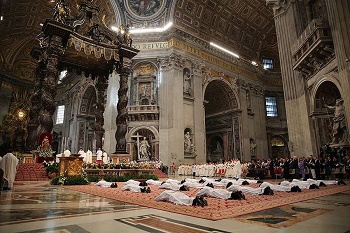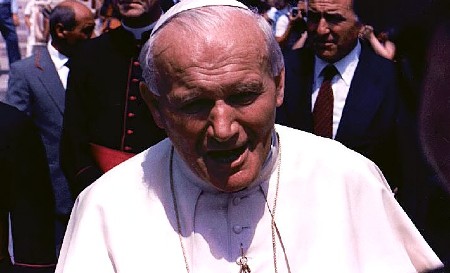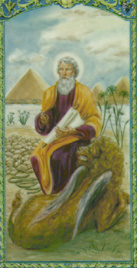We ask you, humbly: don't scroll away.
Hi readers, it seems you use Catholic Online a lot; that's great! It's a little awkward to ask, but we need your help. If you have already donated, we sincerely thank you. We're not salespeople, but we depend on donations averaging $14.76 and fewer than 1% of readers give. If you donate just $5.00, the price of your coffee, Catholic Online School could keep thriving. Thank you.Help Now >
Did Pope Francis Really Call for Married Men to be Ordained as Catholic Priests?
FREE Catholic Classes
I personally believe there is room in the Catholic Church, East and West, for a both celibate and a married clergy, deacons and priests. Both consecrated celibacy and consecrated Christian marriage are a response to the universal call to holiness. They are also a gift to the whole Church because they both participate in the one nuptial or spousal mystery, fully revealed in Jesus Christ. However, what I personally believe is not the issue. It is what the Holy Spirit reveals in guiding the whole Catholic Church. For that, we should look to the teaching office, the Magisterium of the Catholic Church. Is Pope Francis really considering opening the possibility of ordaining mature, proven married men to Priesthood? Time alone will tell. However, if this were to happen it would NOT mean a diminution in the cherished role of consecrated or clerical celibacy.

Ordination of multiple priests in Rome
Highlights
Catholic Online (https://www.catholic.org)
3/13/2017 (7 years ago)
Published in U.S.
Keywords: married priests, celibacy, ordaining married men, Pope Francis, Married deacons, priesthood, Catholic
CHESAPEAKE, VA (Catholic Online) - In a wide ranging interview with a German newspaper on March 8, 2017, Pope Francis was asked to weigh in, once again, on the issue of the possibility of married men being considered for priestly ordination for the Latin Rite of the Catholic Church. There was nothing new in his response. He said what he has said in the past. He reaffirmed the gift of consecrated celibacy and does not favor making it optional.
The Pope also affirmed the possibility of considering viri probati, a Latin phrase for older, proven married men, for ordination to the priesthood in the Catholic Church. He suggested that this possibility merits further, prayerful reflection, in limited pastoral situations, if the Holy Spirit revealed a need in the Church.
However, as is always the case with this topic, the global press had a field day. The Associated Press issued the first article and the media feeding frenzy began. Given the growing interest in this story line, I felt it was an appropriate time to address the topic in a wider context. The titles of the various news reports demonstrate a lack of understanding of the entire subject of married clergy in the Catholic Church, in both secular and religious news services. That includes Catholic sources.
Press reports, opinion pieces and editorials which cover the issue of whether married men may once again be admitted to the Roman Catholic priesthood often pose the question improperly. For example, by asking, Should priests be allowed to marry? That improper way of posing the question either reveals a complete misunderstanding of the issues and the history of the subject - or it can reveal an agenda to assert some perceived kind of pressure on the Church.
None of the discussions over mandatory clerical celibacy for Latin Rite Catholic priests concern those already ordained and pledged to lifelong celibacy. That cannot and will not change. The only issue being raised any of the discussions concerning a change is whether already mature, proven, married men (viri probati) should be allowed to discern a possible vocation to the priesthood and, if chosen by the Church, be ordained to the priesthood? They can already be considered for ordination to the diaconate. In fact, that ordination always precedes ordination to the priesthood.
Married Deacons
First, let us turn to an aspect of this topic which too many Catholics do not know, there are already married clerics in the Western or Latin Rite of the Catholic Church. One example is found in the Order of Deacons. The restoration of the Order was promoted by the Second Vatican Council. Its ranks are open to both married and celibate men. However, the decision concerning state in life must have occurred before the ordination.
We ask you, humbly: don't scroll away.
Hi readers, it seems you use Catholic Online a lot; that's great! It's a little awkward to ask, but we need your help. If you have already donated, we sincerely thank you. We're not salespeople, but we depend on donations averaging $14.76 and fewer than 1% of readers give. If you donate just $5.00, the price of your coffee, Catholic Online School could keep thriving. Thank you.Help Now >
Married men become clerics when they are ordained as deacons. They are no longer laymen. Thus the oxymoron lay deacons, still used by some, reflects a lack of good teaching - and is just plain wrong. Catholic Deacons are ordained members of the Catholic Clergy. They are ordained not to the priesthood but to the ministry. I have served as an ordained Catholic Deacon for twenty one years and opined on the diaconate as a vocation on the Feast of St. Lawrence the Deacon.
The Catechism of the Catholic Church describes this order of Clergy in this way:
At a lower level of the hierarchy are to be found deacons, who receive the imposition of hands 'not unto the priesthood, but unto the ministry. At an ordination to the diaconate only the bishop lays hands on the candidate, thus signifying the deacon's special attachment to the bishop in the tasks of his diakonia. Deacons share in Christ's mission and grace in a special way. The sacrament of Holy Orders marks them with an imprint (character) which cannot be removed and which configures them to Christ, who made himself the deacon or servant of all. (See, CCC #1569-1571)
The adjective permanent, often used to describe married deacons, does not change the nature of the ordination or what is sacramentally conferred with the imposition of the Bishops hands on the man called to the office. A deacon is a deacon. Rather, it denotes the intention of the deacon to remain in that rank of ordered service as a member of the clergy. A transitional deacon intends to be considered for ordination to the priesthood.
There are Already Married Priests in the Catholic Church
Second, we have a growing body of married men who have been ordained to the Catholic priesthood for the Latin Rite. For these men, the discipline of celibacy was dispensed by the Church prior to their ordination. Most come from other Christian communities. The most visible community of these priests have come to us through the Ordinariates established for groups of former Anglicans coming into full communion with the Catholic Church which was opened by the apostolic constitution of Pope Emeritus Benedict in 2009. I addressed this historic gift to the whole Church here. However, there are others, who, through the prior pastoral provision established by Saint John Paul II, were also invited to priestly ordination.
To use an old cliché, some of my best friends are priests and deacons, both celibate and married. They are all living their vocation with dignity and holiness. Within that community of celibate and married priests, there are different kinds of ministry, in the one priesthood of Jesus Christ.
Finally, and many Catholics are still unaware of this fact, in the Eastern Catholic Church there is an unbroken tradition of admitting both celibate and married men to candidacy for the order of deacon and the order of priest. The men must have married before ordination as deacons. In the Code of Canon Law for the Eastern Churches we read:
Clerical celibacy chosen for the Kingdom of Heaven and suited to the priesthood is to be greatly esteemed everywhere, as supported by the tradition of the whole church; likewise, the hallowed practice of married clerics in the primitive church and in the tradition of the Eastern Churches throughout the ages is to be held in honor. Clerics, celibate or married, are to excel in the virtue of chastity; it is for the particular law to establish suitable means for pursuing this end. In leading family life and in educating children married clergy are to show an outstanding example to other Christian faithful. (Canons # 373-375)
Thus, both married and celibate men are considered for ordination to the priesthood from the ranks of deacons in the Eastern Churches. The decision for marriage or celibacy is made before they were ordained as deacons and cannot be changed. Bishops are always celibate and monastic in the Eastern Churches. And, in the instances of married men ordained as deacons or priests, those ordained clerics pledge not to remarry should their spouse die.
The Eastern Church, both Catholic and Orthodox, often assigns married priests to different types of ministry than celibate priests. Similarly, in the Latin rite of the Western Church, married men ordained to the priesthood serve in a manner that reflects and respects their state in life and offers its pastoral witness as a gift to the whole Church. This pastoral concern was noted in the response given by Pope Francis in this recent interview.
Common Root of Consecrated Celibacy and Consecrated Marriage
Consecrated celibacy is a prophetic sign of the Kingdom of God and a gift to the whole Church. It was instituted and lived by Jesus, demonstrated in the lives of many of the Apostles, confirmed in the earliest witness of the ancient Church and affirmed in the unbroken tradition of the Church. (See, e.g., Matt. 19:12) Consecrated Christian marriage is also a prophetic sign and a gift to the Church. The Church is the bride and Jesus the bridegroom. This witness is increasingly important, especially in the current age preoccupied with rejecting marriage as solely possible between one man and one woman, open to life and intended for life.
At the foundation of both chaste, consecrated celibacy and chaste, sacramental marriage is a call to live the nuptial or spousal mystery. The consecrated celibate is called to participate in the nuptial or spousal mystery in an immediate and prophetic way, forsaking one person to be married to all. While the married man participates in a mediated way, through chaste love with one woman - and then through the couple's openness to life which expand beyond the couple to family, the domestic church. Both responses have a prophetic dimension as well as a pastoral one.
However, when love is perfected and complete in the Resurrection there will be no marriage. The teaching of Jesus on this is quite clear. In heaven there will be no marriage. (See, e.g, Mt. 22:30, Mk. 12:25) We will all be married to the Lamb of God, the Bridegroom, the Lord Jesus Christ and live in the eternal communion of Trinitarian Love where all love is completed and perfected. (See, Rev 19:7-10) The Church is the Bride of Christ.
The prophetic witness of voluntary, consecrated celibacy has endured by God s loving design and is revealed beyond the ranks of celibate clergy. It is present in the vowed life of monastic orders and the sacrificial witness of religious men and women in the numerous religious orders and communities which provide such a beautiful gift for the Church and her mission.
In addition, in many of the ecclesial movements and associations of lay men and woman, consecrated celibacy is being freely chosen, not to avoid marriage, but to enter more fully into the very nuptial mystery that marriage also reveals, in a unique and prophetic way, and be more available for mission.
I write with deep appreciation for the celibate vocation among the ordained ministers of the Church, the religious orders and the growing lay ecclesial movements. I have had the privilege of knowing some profoundly holy consecrated celibates in each of these vocational responses. This gift will continue.
What Does the Catholic Church Really Teach?
So, what does the Catholic Church actually teach concerning this issue which has once again attracted so much attention - the possibility of the Latin Rite considering mature, proven, married men for ordination to the priesthood? Rather than rely on secondary sources which so often surround the discussion of this matter, let us turn to the Catechism of the Catholic Church for what the Church teaches.
This should settle the matter for most, except perhaps a few of my traditionalist Catholic brethren who simply do not like the practice of allowing married men to be ordained at all, whether to the order of deacon or the order of priest. Some seem to even be suspect of what some of them still call the new Catholic Catechism, even though it has been around for twenty five years.
These paragraphs are taken from the treatment of Holy orders in Article Six of the Official Catechism of the Catholic Church. I commend this entire section to everyone who wants to understand the issues surrounding the gift of ordained service to the whole Church. The Catechism contains important footnotes to sources of authority, drawn from the Scriptures and the sacred Tradition, which are well worth a more in depth study.
Remember, if you want to know what the Catholic Church REALLY teaches, go first to the Scriptures and to the Catholic Catechism and to teaching of the Magisterium, not to the those who give you their own opinion. Some even improperly use sources of authority as proof texts for pushing their own agendas, in order to change the Church rather than be changed by the Church, by lovingly embracing her teaching. Here are the words of the Catechism concerning clerical ordination:
Only a baptized man (vir) validly receives sacred ordination. The Lord Jesus chose men (viri) to form the college of the twelve apostles, and the apostles did the same when they chose collaborators to succeed them in their ministry. The college of bishops, with whom the priests are united in the priesthood, makes the college of the twelve an ever-present and ever-active reality until Christ's return. The Church recognizes herself to be bound by this choice made by the Lord himself. For this reason, the ordination of women is not possible. "
No one has a right to receive the sacrament of Holy Orders. Indeed no one claims this office for himself; he is called to it by God. Anyone who thinks he recognizes the signs of God's call to the ordained ministry must humbly submit his desire to the authority of the Church, who has the responsibility and right to call someone to receive orders. Like every grace this sacrament can be received only as an unmerited gift.
All the ordained ministers of the Latin Church, with the exception of permanent deacons, are normally chosen from among men of faith who live a celibate life and who intend to remain celibate for the sake of the kingdom of heaven. Called to consecrate themselves with undivided heart to the Lord and to "the affairs of the Lord," they give themselves entirely to God and to men. Celibacy is a sign of this new life to the service of which the Church's minister is consecrated; accepted with a joyous heart, celibacy radiantly proclaims the Reign of God.
In the Eastern Churches a different discipline has been in force for many centuries: while bishops are chosen solely from among celibates, married men can be ordained as deacons and priests. This practice has long been considered legitimate; these priests exercise a fruitful ministry within their communities.
Moreover, priestly celibacy is held in great honor in the Eastern Churches and many priests have freely chosen it for the sake of the Kingdom of God. In the East as in the West a man who has already received the sacrament of Holy Orders can no longer marry." (CCC #1577 - 1579)
Conclusion and Opinion
For members of the media reading this article looking for news, please report this, Catholics already have married clergy - deacons and priests. In the Eastern Catholic Churches, the practice of admitting married men to the priesthood has existed for centuries. In the Latin Rite of the Catholic Church, the body of married priests has increased with the ordinariates established for former Anglican Christians who have come into the full communion of the Catholic Church.
For Roman Catholic Christians reading this article, we must learn from all of this and trust that the Lord is behind it. If there is to be a change in the discipline of mandatory celibacy as a requirement for men considered for ordination to the priesthood in the Latin Rite, the Lord will unfold it through those whom he has chosen to lead His Church.
When I was invited to Holy Orders as a Deacon, I knew that it was a life altering vocation, not a weekend task. As a Married man, I pledged to embrace celibacy if my wife should predecease me. My wife gave her consent. I soon came to understand the theology I had studied and have studied since; there truly is an ontological change which occurs at ordination. My life was turned upside down and has never been the same.
I personally believe there is room in the Catholic Church, East and West, for a both celibate and a married clergy, deacons and priests. Both consecrated celibacy and consecrated Christian marriage are a response to the universal call to holiness. They are also a gift to the whole Church because they both participate in the one nuptial or spousal mystery, fully revealed in Jesus Christ.
However, what I personally believe is not the issue. It is what the Holy Spirit reveals in guiding the whole Catholic Church. For that, we should look to the teaching office, the Magisterium of the Catholic Church. Is Pope Francis really considering opening the possibility of ordaining mature, proven married men to Priesthood? Time alone will tell. However, if this were to happen it would NOT mean a diminution in the cherished role of consecrated or clerical celibacy in the Church.
We ask you, humbly: don't scroll away.
Hi readers, it seems you use Catholic Online a lot; that's great! It's a little awkward to ask, but we need your help. If you have already donated, we sincerely thank you. We're not salespeople, but we depend on donations averaging $14.76 and fewer than 1% of readers give. If you donate just $5.00, the price of your coffee, Catholic Online School could keep thriving. Thank you.Help Now >
-----------------------------------
Deacon Keith Fournier is the Editor in Chief of Catholic Online and the Founder and President of the Common Good Foundation. He was ordained as a member of the Clergy, a Deacon, twenty one years ago. Deacon and his wife Laurine have been married forty one years, have five grown children and seven grandchildren
---'Help Give every Student and Teacher FREE resources for a world-class Moral Catholic Education'
Copyright 2021 - Distributed by Catholic Online













 Daily Readings for Thursday, April 25, 2024
Daily Readings for Thursday, April 25, 2024 St. Mark: Saint of the Day for Thursday, April 25, 2024
St. Mark: Saint of the Day for Thursday, April 25, 2024 Prayer for Policemen: Prayer of the Day for Thursday, April 25, 2024
Prayer for Policemen: Prayer of the Day for Thursday, April 25, 2024


